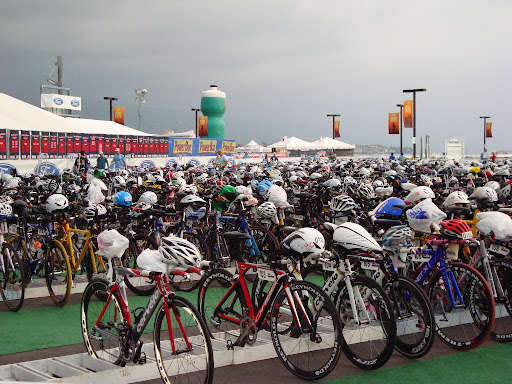
The
Ironman World Championship in Kona over the weekend marks the unofficial end to the 2011 triathlon season. Kona, however, also provides manufacturers a chance to see how their products stacked up against the competition... or at least in the eyes of some of the most elite triathletes in the world.
The
Kona Bike Count accurately registers all bikes, wheels, components, etc. (basically anything bike related the athlete takes into transition) compiled by members of the industry. Though it has evolved into recording more products in greater detail, such as drinking systems, the spirit of it hasn't changed much since it was started by Dan Empfield of
Slowtwitch in 1992 (then owner of Quintana Roo).
For all intensive purposes, the Kona Bike Count is the ultimate barometer by which all triathlon equipment is judged.
 Photo courtesy of slowtwitch.com
Photo courtesy of slowtwitch.comJust like we've come to expect Chrissie Wellington atop the podium in any race she enters, the Kona bike count has become somewhat anticlimactic. But it's a much more interesting story than that. It is not 4 out of the last 5 years, it's not 5 out of 6, or 6 out of 7 years. I'm referring to
Cervelo's sheer dominance of the bike count over the last 7 years -
winning it every single year.
Why is this impressive? for starters, competition is tough. Especially with companies such as Trek, Specialized, Cannondale, Scott, and others.
Companies with bigger budgets tend to have an advantage as they have a lot more resources. Cervelo's achievement is highlighted by the fact that these
amateurs are mostly paying for their bikes themselves. Unlike the pro's, who tend to ride what they get paid to ride,
amateurs get to pick their equipment on what they feel is the best for them.
Cervelo has also proven that if it ain't broke, it doesn't need to be fixed. Though often criticized for having the same triathlon models from year to year, Cervelo has stuck to its guns.
Why change for marketing reasons? If a frame can't be improved significantly enough for the rider to notice, it doesn't need to be redesigned.


Finally, this ongoing 7 year streak is most impressive given that as with anything or anyone at the top, everyone below is aiming to knock them down. Combined with consumers, especially triathletes, who tend to change buying habits often, Cervelo's streak speaks to the quality of the product and the vision of the company. Think it's a fluke? or a complicated formula for success? It isn't,
Profile Design and
Zipp are two good examples of companies who've shared that success.





























